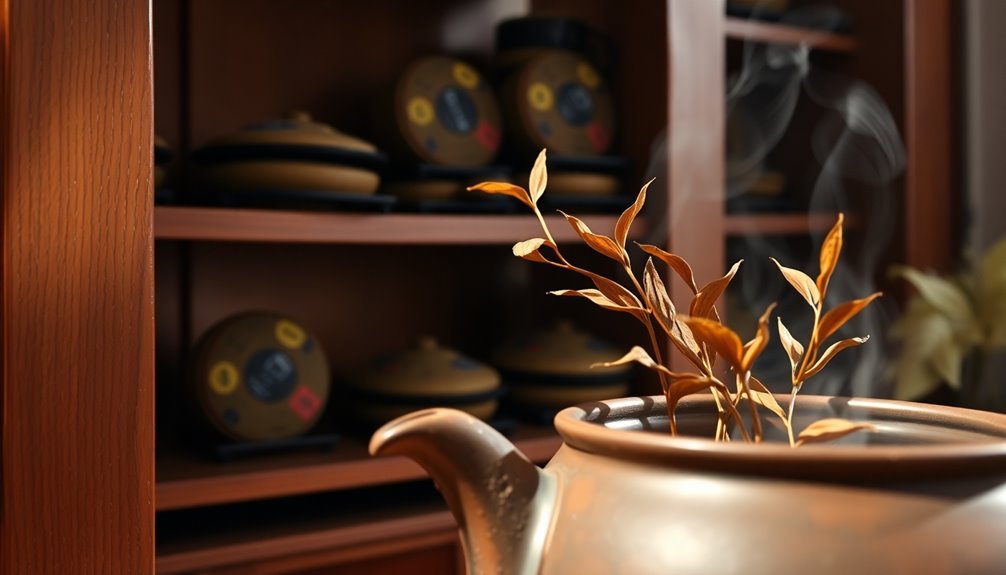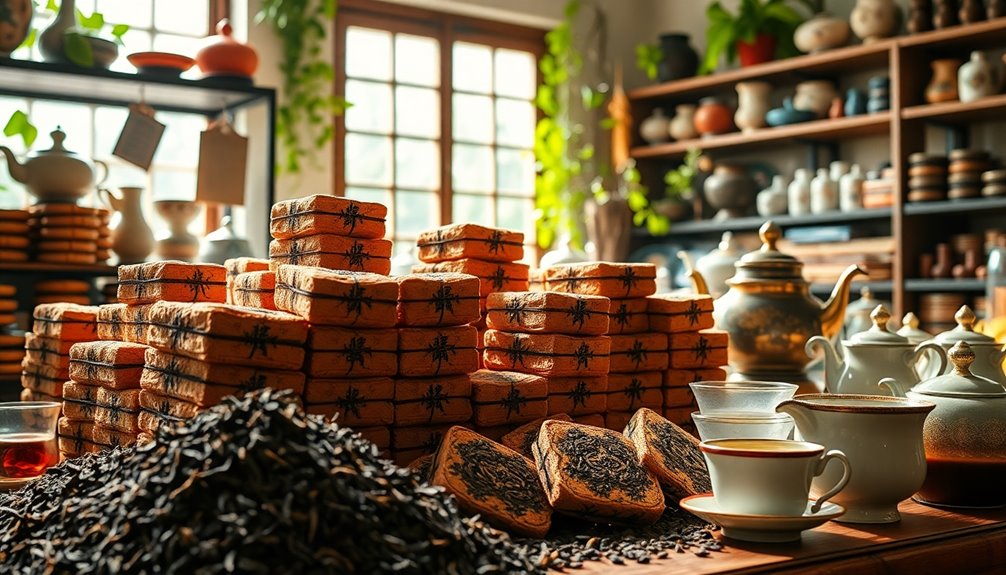Aging pu-erh tea is often called the fine wine of teas because it develops rich, complex flavors over time, just like wine. When you let pu-erh age for years, it transforms from young, floral notes to smooth, earthy tastes. This aging process can unlock a variety of flavors and aromas, making each cup different and exciting. Plus, high-quality pu-erh can be steeped multiple times, allowing you to enjoy its evolving character. Its value goes up too, with some vintage pu-erh selling for thousands. Keep exploring, and you'll discover even more about this fascinating beverage!
Key Takeaways
- Pu-erh tea undergoes microbial fermentation and aging, developing complex flavors similar to the aging process of fine wine.
- Aged pu-erh can reveal intricate flavor profiles that evolve with each steep, much like vintage wines.
- The peak complexity of pu-erh is often achieved after five to thirty years, paralleling the aging of fine wines.
- High-quality pu-erh can be steeped multiple times, maintaining robust flavors, akin to savoring various notes in a well-aged wine.
- Vintage pu-erh's market value, reaching up to $5,000, highlights its investment potential, similar to collectible wines.
Introduction

When you think of tea, you mightn't immediately consider aging as a factor that can enhance its flavor, but pu-erh tea defies that notion. This unique tea undergoes a complex aging process involving microbial fermentation, which significantly alters its flavor profile over time.
While young raw pu-erh can taste floral or even bitter, aged raw pu-erh develops mellow characteristics that are smooth and earthy, making it highly sought after by collectors.
Just like fine wines, high-quality pu-erh tea reveals different notes with each steep, allowing you to experience a variety of flavors. Imagine sipping a cup of aged pu-erh and noticing how its richness unfolds, much like a fine wine opening up.
The aging process can transform these teas into treasures, with vintage pu-erh fetching prices up to $5,000, showcasing their investment potential.
Aged for Decades, Complex Flavors

Aging pu-erh tea for decades unlocks a world of complex flavors that captivate the palate. This remarkable tea undergoes a sophisticated aging process through microbial fermentation, allowing it to evolve beautifully over time, much like fine wine. The magic happens as the tea matures, often reaching its peak complexity after five to thirty years.
As you explore aged pu-erh, you'll notice how the flavor profiles change dramatically. Young raw pu-erh starts with youthful, grassy notes, but as it ages, it transforms into rich, earthy, and woodsy characteristics that delight tea enthusiasts. Each sip reveals layers of depth that keep you coming back for more.
High-quality aged pu-erh can be steeped multiple times, offering 10 to 12 brews while maintaining its robust flavors in each infusion. This ability to deliver consistent taste makes it even more appealing.
Plus, the market for vintage pu-erh is thriving—cakes from the 1960s can sell for $3,000 to $5,000! This highlights not just the tea's value, but its desirability among collectors.
Aging Enhances Flavor Profile

The aging process transforms pu-erh tea into a rich tapestry of flavors that evolve with time. As you explore this tea, you'll notice how the fermentation process enhances its flavor profile.
Young, raw pu-erh might taste floral or even a bit bitter. But as it ages, those sharp notes give way to smooth, earthy flavors that are truly delightful.
For cooked pu-erh, the wet-piling method speeds up fermentation, resulting in a darker tea that's easier to drink. This aging creates a complex flavor profile, making each sip a journey through layers of taste.
High-quality pu-erh can be steeped multiple times—up to 10 or 12—allowing you to savor how the flavors shift with each brew.
As you enjoy aged pu-erh tea, you'll see why it's so sought after. The aging process not only makes it more expensive but also deepens the intricate flavors that develop over time.
Cultural Significance in Ceremonies

Pu-erh tea holds a special place in traditional Chinese tea ceremonies, where its rich history and aging process are celebrated akin to fine wines. During these ceremonies, you'll discover how the unique flavors and aromas of aged pu-erh unfold, allowing everyone to savor its complex character developed over years.
Cultural practices surrounding pu-erh tea highlight its importance in hospitality. When you offer vintage pu-erh to guests, it shows respect and appreciation, making them feel welcomed. This treasured beverage is often shared during special occasions, reinforcing social bonding and community spirit.
The ritualistic aspects of these ceremonies involve specific brewing techniques that enhance the tasting experience. You'll notice how each step is executed with care, showcasing the artistry behind serving this "drinkable antique."
From selecting the right leaves to the way water is poured, every detail counts.
As you participate in a traditional Chinese tea ceremony, you become part of a rich cultural tapestry, celebrating not just the tea, but the connections formed through shared moments over a cup of exquisite pu-erh tea.
Enjoy the journey and let those flavors transport you!
Quality Variability Among Producers

When diving into the world of pu-erh tea, you'll quickly notice how quality can vary dramatically among producers. This quality variability is influenced by many factors, including sourcing, processing methods, and aging techniques.
Authentic pu-erh must come from Yunnan Province, where the best producers follow meticulous standards for leaf selection and processing. This ensures a premium product that stands out in flavor and complexity.
Regions within Yunnan, like Yiwu and Bulang, are famous for their distinct flavor profiles. When you taste tea from ancient trees, you'll discover why it often commands higher prices.
The fermentation process is crucial, as it greatly affects the taste and quality of pu-erh tea. Different producers use varying methods, leading to unique flavors, aromas, and aging potentials.
As demand for high-quality aged pu-erh grows, prices rise, creating a competitive market. Collectors often seek out teas from well-known producers, appreciating their craftsmanship and authenticity.
Practical Applications

Understanding quality variability among producers paves the way for practical applications in enjoying and aging pu-erh tea. When you choose high-quality varieties, you're setting the stage for an amazing aging process. These teas undergo microbial fermentation, enhancing their flavor profile over time. In fact, the use of non-toxic materials in craftsmanship can significantly influence the quality and safety of tea storage containers. Coffee, similar to pu-erh tea, benefits from polyphenols that contribute to its unique flavors and health properties.
Investing in pu-erh tea can be likened to diversification strategy in finance, as it allows you to spread your interest across different flavors and ages.
You'll find that older pu-erh, especially those aged over five years, features earthy notes and a smoothness that makes it irresistible to tea connoisseurs. Essential oils can also be used to create a soothing atmosphere while enjoying your tea, enhancing the overall experience.
To achieve optimal aging, store your pu-erh tea in a cool, dry place. Using unglazed clay containers helps maintain the tea's integrity and boosts flavors. Dark coffee roasts, much like aged pu-erh, offer a bolder flavor experience that can be savored over time.
As you sip your tea, remember that you can steep it multiple times. High-quality pu-erh can deliver flavor through 10-12 infusions, allowing you to experience its evolving taste with each steep.
As you explore different aged teas, notice how the flavor deepens and transforms, revealing new dimensions to enjoy. Additionally, understanding risk management strategies can enhance how you approach investing in high-quality pu-erh tea.
Whether you're savoring a vintage cake or trying something fresh, embrace the journey of pu-erh tea. By understanding these practical applications, you'll not only enjoy this fine tea but also appreciate its rich history and craft.
Happy brewing!
Frequently Asked Questions
What Is Special About Pu Erh Tea?
Pu-erh tea's special because of its unique aging process, where microbial fermentation enhances flavors over time. You'll discover earthy, floral, and sweet notes, making each sip an evolving experience that captivates tea lovers everywhere.
Does Pu Erh Tea Get Better With Age?
Yes, pu-erh tea does get better with age. As it matures, you'll notice richer flavors and a smoother texture. The aging process also enhances its health benefits, making it a delightful choice for tea lovers.
What Makes Puerh Tea Special?
Pu-erh tea's special because of its unique aging process, diverse flavor profiles, and the ability to improve with time. You'll discover earthy notes and rich complexities, making each cup a delightful journey for your palate.
What Are the Negative Effects of Pu Erh Tea?
Excessive pu-erh tea can cause digestive issues, headaches, or insomnia due to caffeine. It might interfere with iron absorption, and if improperly stored, could introduce mycotoxins. Those with ulcers should limit their intake.
Conclusion
In conclusion, aging pu-erh tea truly deserves its title as the fine wine of teas. With its rich history and complex flavors, it offers a unique experience for tea lovers. As you explore different aged pu-erh teas, remember that each sip tells a story of time and tradition. Don't hesitate to share this delightful beverage during special moments or simple gatherings. Enjoy the journey of discovering your favorite aged pu-erh, and let its flavors surprise you!










